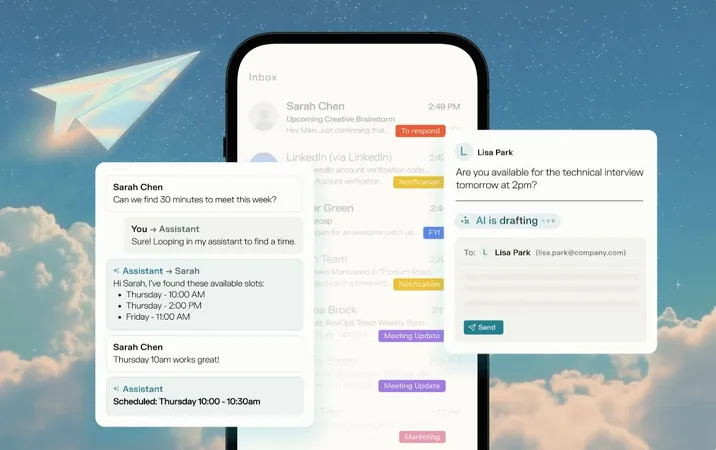
Asteroid Gold Rush: Will Earth's Next 'Mini-Moon' Spark a Mining Revolution?
2025-09-21
Author: Daniel
Asteroid Visit Sparks New Mining Hopes
Just last year, the scientific community marveled as an asteroid dubbed 2024 PT5 briefly entered Earth’s orbit, hanging above us for nearly two months. While asteroids are often scrutinized for their potential danger to our planet, they also represent a treasure trove of valuable metals. This duality has ignited a frenzy among space entrepreneurs and researchers eager to tap into these extraterrestrial resources.
The Wealth of Asteroids
Asteroids, primarily found in the asteroid belt between Mars and Jupiter, are rich in metals pertinent to modern technology, including platinum, cobalt, and even gold. NASA estimates that the metals contained in asteroids could equate to a staggering $100 million per person on Earth, with the prospect of extracting just a handful of the most lucrative asteroids possibly generating up to $1.5 trillion.
Can We Mine Space Rocks?
Despite the enormous wealth potentially awaiting us, the critical challenge remains: how do we access these metals? While previous missions like NASA's OSIRIS-REx and Japan’s Hayabusa2 have successfully returned asteroid samples, the high cost—ranging from $10 million to $150 million per gram—poses a significant barrier for commercial ventures.
Opportunity Knocks with Mini-Moons
Mini-moons, like 2024 PT5, could be the answer. Far more accessible than distant asteroids, these temporary captives of Earth's gravitational field represent an ideal target for mining activities. As space mining startups scramble to prepare for the next mini-moon opportunity, the potential for long-term resource acquisition in space is becoming increasingly tangible.
Navigating the Challenges of Space Mining
Although the notion of asteroid mining is exciting, it isn’t without complications. Experts debate the frequency of mini-moons, with fewer than 10 spotted in the last decade. Furthermore, reaching an asteroid has its own set of hurdles, ranging from temperature extremes to the pervasive radiation in space, complicating mission logistics.
A New Era of Detection
Fortunately, technological advances at the Vera C. Rubin Observatory may change the game. With capabilities to enhance asteroid detection, the observatory is paving the way for future discoveries. These breakthroughs signal that asteroid mining might soon shift from a theoretical endeavor to a lucrative reality.
An Evolving Global Market for Rare Metals
Funding the necessary technology to mine asteroids has been complicated. The vast majority of rare earth metal exports are controlled by Chinese companies, pushing American and global firms to seek alternative sources. Asteroids could provide abundant metals like copper, nickel, and platinum, pivotal for renewable energy infrastructure.
Innovative Concepts in Space Mining
Companies like Tethers Unlimited are exploring creative solutions, such as deploying gigantic nets to capture asteroids rather than landing on them. Meanwhile, TransAstra’s ambitious plan involves wrapping these mini-moons in a giant plastic bag to exploit concentrated sunlight for breaking down water-rich asteroids, leaving behind the precious metals.
The Promise and Peril of Asteroid Mining
As space agencies like NASA prepare to launch groundbreaking missions, including plans for the Psyche probe—targeting a metal-rich asteroid estimated to be worth quadrillions—questions about the implications for Earth’s economy arise. Rapidly increasing supplies of rare materials could drastically shift market dynamics, reminiscent of the oil industry.
The Future of Space Mining is Uncertain
Despite the excitement, many companies face significant challenges securing consistent funding and project viability. With some initiatives already folding under financial strain or personnel loss, the path to a flourishing asteroid mining industry remains fraught with uncertainty. As we gaze into the cosmos, the potential for a golden era of mining may be on the horizon, but only if the hurdles can be navigated successfully.



 Brasil (PT)
Brasil (PT)
 Canada (EN)
Canada (EN)
 Chile (ES)
Chile (ES)
 Česko (CS)
Česko (CS)
 대한민국 (KO)
대한민국 (KO)
 España (ES)
España (ES)
 France (FR)
France (FR)
 Hong Kong (EN)
Hong Kong (EN)
 Italia (IT)
Italia (IT)
 日本 (JA)
日本 (JA)
 Magyarország (HU)
Magyarország (HU)
 Norge (NO)
Norge (NO)
 Polska (PL)
Polska (PL)
 Schweiz (DE)
Schweiz (DE)
 Singapore (EN)
Singapore (EN)
 Sverige (SV)
Sverige (SV)
 Suomi (FI)
Suomi (FI)
 Türkiye (TR)
Türkiye (TR)
 الإمارات العربية المتحدة (AR)
الإمارات العربية المتحدة (AR)